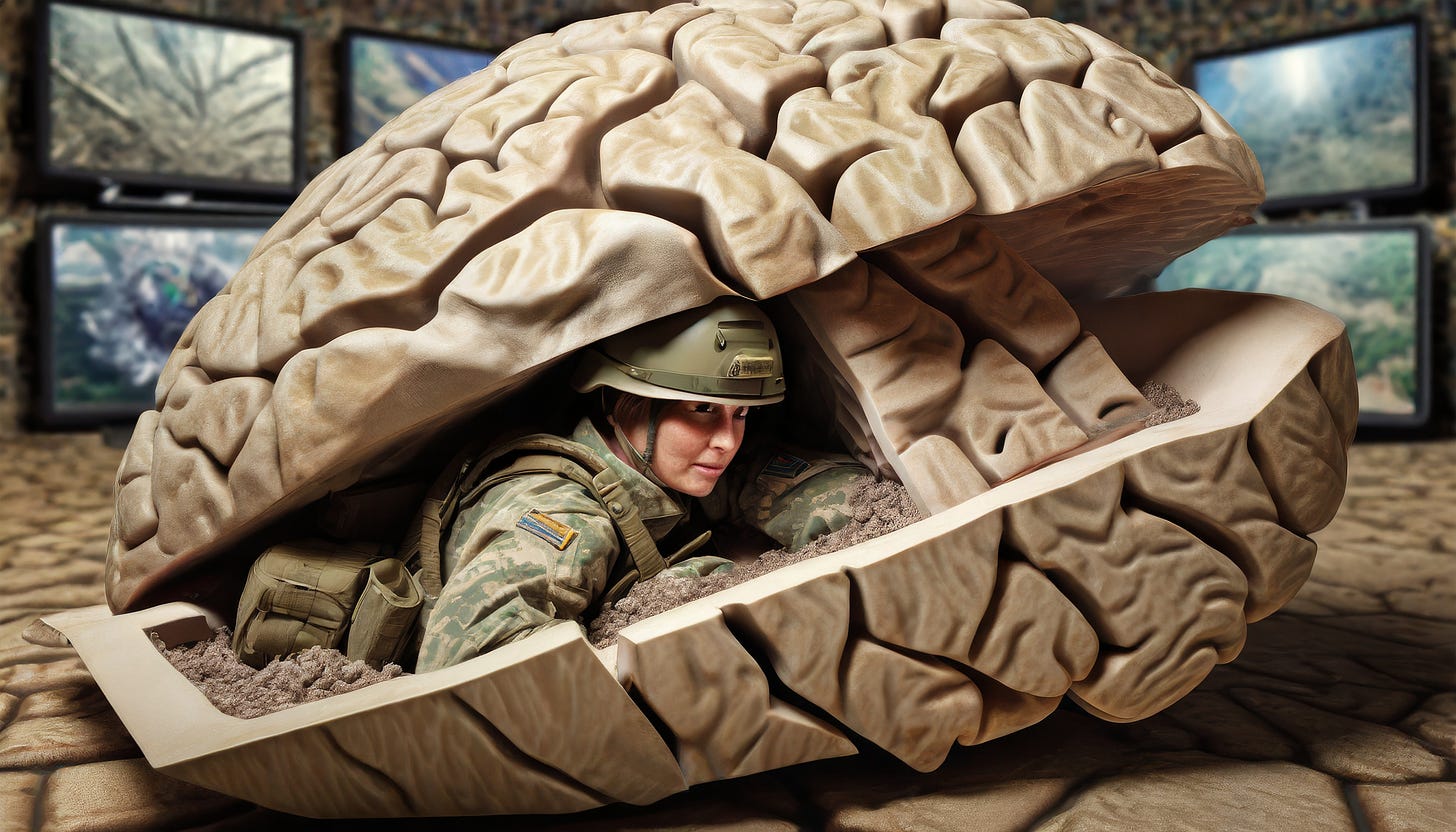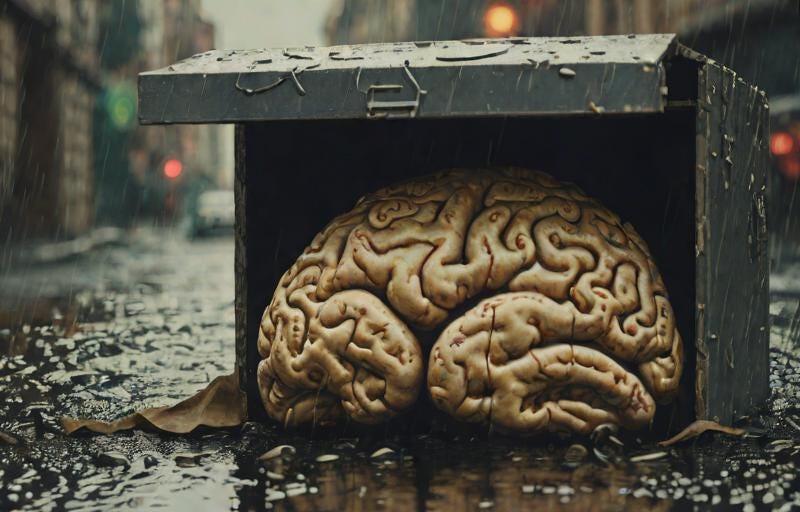How Your Western Brain Exposes You to 5G Warfare
Living in the Cognitive Trenches of the Left Hemisphere
In the era of modernity, the confluence of news coverage, social media, and evolving consumer technology has ushered in a profound transformation in the way we perceive and engage with the world.
Recently inspired by "The Master and His Emissary," by Ian McGilchrist, which delves into the left hemisphere entrenchment in the Western brain, I have deeply considered what this means for the fifth-generation cognitive battlefield.
McGilchrist’s undertaking is monumental in that it outlines, with an incredible amount of empirical evidence, the Western population living entrenched in the left hemisphere of the brain. Consequently, he also proves that we are struggling to use the beneficial qualities of the right hemisphere and even perceive that we are trapped in this way.
As a student of warfare, I immediately took this in as insight into a battlefield that I knew to be mostly cognitive.
After all, a war that’s primarily composed of weaponized stories and influence operations is by definition cognitive in nature. This also means that to be any good at attacking us, our enemy has likely taken advantage of the Western brain and utilized points of influence and weakness.
The issue is not just that psychological operations surround us, but that it is our very Western brains that are being operated on.
Here are a few quotes from The Master and His Emissary that give a foundational understanding of what it means to be entrenched in the left hemisphere of the brain (*Emphasis throughout the article’s quotes are added by me):
“The left hemisphere view is designed to aid you in grabbing stuff. Its purpose is utility and its evolutionary adaptation lies in the service of grasping and amassing things, and as such it is seductive.”
The grasping and amassing of things referred to here is relevant on two levels. The first is the most obvious: the quest to gather more control over the material realm.
But the second implication has to do more with the amassing of thoughts as things. In other words, the left hemisphere seeks ‘knowings.’ It seeks forms of certainty that can be grabbed like an item and kept along with the rest of the knowledge being fed into one particular worldview.
[T]he left hemisphere is concerned with what it knows, where the right hemisphere is concerned with what it experiences.”
“The right hemisphere is able to maintain ambiguous mental representations in the face of a tendency to premature over-interpretation by the left hemisphere. The right hemisphere's tolerance of uncertainty is implied everywhere in its subtle ability to use metaphor, irony and humour, all of which depend on not prematurely resolving ambiguities.”
Here, McGilchrist points out perhaps one of the most pertinent challenges we face: the excess of certainty caused by left hemisphere entrenchment. Our habitual reliance on the left hemisphere, at the expense of the right, has meant that we avoid uncertainty simply to stay in the comfortable worldview the left hemisphere has created for us.
When this left hemisphere attachment to being sure is paired with the fact that we are surrounded by weaponized narratives that seek to create designer forms of certainty in us, a great vulnerability in the general population is revealed.
What is the significance of this modern dilemma now that we are living through a fifth-generation war, a war that focuses primarily on cognition?
How can awareness of our neuro-cultural conditioning help us navigate the war at hand?
I present this article in the hopes that it will produce more situational awareness of this historically unique battlefield.
Disembedding Mechanisms in Modern Life
One of the concepts McGilchrist explores most pertinent to fifth-generation warfare is the idea of the left hemisphere’s ‘disembedding mechanisms.’ These mechanisms characterize contemporary, left hemisphere existence unique to the West, as an example of how disembodied we are conditioned to be.
By ‘disembedding mechanisms,’ he is referring to modern influences that remove us from the physical world surrounding us and the reality of our bodies. The act of disembodying us and the act of removing the significance of our local surroundings are both unavoidable influences of the post-industrial age, argues McGilchrist.
One of the thinkers McGilchrist cites on the concept of disembedding mechanisms is sociologist Anthony Giddens:
“Anthony Giddens describes …what he calls disembedding mechanisms, the effect of which is to separate things from their context and ourselves from the uniqueness of place, what he calls locale. Real things and experiences are replaced by symbolic tokens. Expert systems replace local know-how.”
Giddens' concept of disembedding mechanisms is particularly relevant in understanding the contemporary cognitive landscape. These mechanisms operate on two fronts:
“The media… promote fragmentation by a random juxtaposition of items of information, as well as permitting the intrusion of distant events into everyday consciousness', another aspect of decontextualization in modern life adding to loss of meaning in the experienced world.”
Let’s start with ‘the intrusion of distant events into everyday consciousness.'
This aspect of the disembedding mechanism operates by constantly removing individuals from their local, embodied context.
I am watching this social media video footage of bloody bodies in Gaza [from home], [on the train], or [in my neighbourhood park.]
Secondly, they operate by presenting information devoid of its original context, ‘a random juxtaposition of items of information.’
Look at this 3-second clip of the war in [Ukraine.] Now consume [this news station’s] biased narrative. Now watch this commercial for [Viagra.]
First comes the decontextualization, then the random juxtaposition. Both elements of the ongoing onslaught of information work together to create the disembedding mechanism that keeps us locked in left hemisphere thinking.
The result of this perpetual ritual is a focal shift towards symbolic tokens, as real experiences are replaced by fragmented, decontextualized information.
This dilemma seems like an unavoidable part of modern life, and maybe it is, but this normalization process makes this a form of largely invisible conditioning. This conditioning is deeply cognitive and must therefore be examined according to the fact that we live on a cognitive battlefield.
The news, as it is consumed through traditional broadcast means and social media, is perhaps the most powerful example of this modern form of decontextualization and disembodiment.
Let’s take an even deeper look at another example of the news reporting on a war to get a better sense of the implications:
On the evening news broadcast, a war from somewhere on the other side of the earth is delivered into your living room.
In a meeting room, before the broadcast, the war between Israel and Palestine is chosen over the war in Armenia or the current genocide in the Congo as your primetime news. The claim is not that you need to be made generally aware of the other wars being waged in this world, it’s that you need to be acutely aware of THIS PARTICULAR WAR.
Then the decontextualization is taken even further.
It’s not just that this war is more important than the other, but that this one particular interpretation of this one fragmented moment of the war is more important.
We should not take it lightly that these are each layered rituals removing us further and further from life itself because our cognition is pushed further and further into the left brain as a result.
You’re in your living room. You can smell the dinner being cooked in the kitchen. You can hear your kids playing upstairs, but your nervous system is being plugged into something completely different. Your nervous system is being played like an instrument not by the war itself, but by the nature and severity of the story being told to you.
After the carefully crafted 2-5 minute news blurb is fed into your brain and body, the news coverage suddenly switches to a story about a dog and a dolphin becoming best friends.
In the case of social media, you’re also consuming this news clip as it has been saturated by likes, comments and the spin of the influencer who shared it.
The cognitive implications of scrolling from a distant war to a goofy meme is comparatively similar to the TV news going from the top story of the night to the feel-good story at the end.
You get through the graphic news clip of today’s chosen war on the other side of the earth and then swipe up to consume an AI-generated clip of Will Smith furiously eating spaghetti.
This process of having our bodies dissociated from the physical world around us, and stimulated by out-of-context stories that are not a part of our particular locale, is occurring with such intensity and so frequently that we don’t question it at all.
This process is so incredibly normalized ,most of us fail to consider how strange all of it truly is, but more importantly, we don’t realize that it’s training our cognition to ignore all the benefits of right-hemisphere thinking.
What does it mean for your cognitive function, and your view of the world that this out-of-context war is suddenly juxtaposed by the story of the dolphin and the dog, or AI Will Smith chugging spaghetti?
I don’t ask these questions simply to point to the left hemisphere entrenchment. I ask them because it is the perpetual act of questioning this disembodiment ritual that is needed.
It is needed because this is the nature of the cognitive battlefield, and the field itself needs to be distinguished from the enemy and the weapons.
Armies survey the battlefield to establish perimeters and assess where to dig entrenchments. Now that the line between citizen and soldier has faded away, should we not take on the challenge of surveying our own battlefield in ways that are suited to its nature?
Our cognitive conditioning needs to be distinguished from weaponized attempts to modify our cognition.
It is deeply relevant that we have been entrained for generations to normalize these forms of disembodiment because it dictates the weapons that can be used against us.
According to the influence of your phone, and the normalized drone of social media, where you are doesn’t matter. The people around you, the weather, the smells, the plant and animal life all slip into irrelevance in a split second.
Both you (the disembodied being) and that which you are consuming are suddenly profoundly out of context.
Perhaps most profoundly, and the reason I wrote this article, is that this is all fodder for the left hemisphere. These forms of conditioning are like a drug for the left hemisphere’s sense of control over your perception, at the expense of all the benefits of the right hemisphere on a cognitive battlefield.
You are being severely limited by your modern conditions before you are being operated on psychologically by the enemy.
The Digital Domain Versus the Physical Domain
“The 'homeless' mind: attachment to place runs deep in us. In neurological terms, the evolutionary roots of the integrated emotional system involved in the formation of social attachments may lie in more ancient and primitive animal attachments to place. Some animals bond as much with their nest sites as with their mothers.”
If we are beings whose bodies and brains are meant to be deeply integrated with our physical surroundings, it’s worth asking: What does it mean when the majority of our daily cognition is at the behest of the digital domain?
Depictions of fifth-generation warfare, such as those offered by General Flynn and Boone Cutler in their book The Citizen’s Guide to 5GW, state that the majority of 5GW occurs in the digital domain.
This is precisely why Boone & Flynn advocate that you ‘Dominate the physical domain,’ as a direct means of cutting through mind control and censorship.
This may sound obvious, but engaging with the world primarily through the digital domain perpetuates the replacement of genuine experiences with symbolic tokens. This is only advancing further with the introduction of technology like the Apple Vision Pro.
Consider this alongside the clear dichotomies drawn out by McGilchrist in the difference in function and preference when it comes to the right and left hemispheres of the brain:
“The left hemisphere view offers simple answers. Its mode of thinking prizes consistency above all and claims to offer the same mechanistic models to everything that exists. This thinking is common to those who espouse naive reductionist science (‘scientism’), enthusiasts for technological solutions to what are complex problems, and designers and implementers of bureaucratic systems.”
Do these tendencies not point to some of the tactics wielded by our enemy? How often have scientism and reductionism been used as a weapon against the people in the realm of health freedom? Wasn’t this, and the mechanized view of the human body, the ammunition used to coerce people into taking the jab?
How often is the ever-expanding bureaucracy used as a weapon to disempower the people?
Aren’t materialism and literalism part of the woke agenda’s intent to sanitize our culture of the divine?
Given these parallels between our enemy’s weapons and the addictive tendencies of the left hemisphere, how much of our current cultural struggle is emerging as a fallout of the Western neurological condition?
Certainly, there are endless psyops at play, but given the habitually narrow view of our left brain and how often it is reinforced, what of this struggle is a part of the cognitive battlefield and what of it is as a result of us being targeted?
The Post-Industrial Revolution Condition
Important to note is that, according to McGilchrist, much of this influence is a natural outcome of the industrial revolution. Why does this matter? Because what is being described is not covert warfare or corporate, consumerist social engineering, but the battlefield on which those operations are being waged.
“[I]t is the Industrial Revolution which enabled the left hemisphere to make its most audacious assault yet on the world of the right hemisphere - or perhaps one should say that the left hemisphere's most daring assault was the Industrial Revolution.”
"Since the industrial revolution … the natural world, cultural tradition, the body, religion and art have been so conceptualized, devitalized and deconstructed…that their power to help us see intuitively beyond the hermetic world the left hemisphere has set out, has been largely drained from them.”
This has to make one wonder: Even if all the PSYOPs disappeared today, what of our socio-cultural struggles would remain?
Or, think about it this way: If the Deep State was purged and shut down completely today, what struggles would remain as a result of Western cognition itself?
What can we learn from examining the difference between our current situation and how life was conditioning human cognition before the Industrial Revolution?
“A century ago, the physical environment was for most of humanity that of the natural world, with its rhythms and cycles, its organic, ever-growing and ever-changing interdependent life, a world to which it seemed intuitively obvious that we belong; now it has been replaced for many by an unyielding, inert, confrontational environment of non-living surfaces, straight lines, concrete masses and largely generic shapes, which are widely experienced as alienating.
The result is that the left hemisphere's world has become externalized, so that when the counterbalancing tendency of the right hemisphere to check with the real world of experience is brought into play, it is already subverted: the world 'out there' is already colonized by the left hemisphere's vision. There is a self-reflexive hall of mirrors at work, where logic seems to lead back to a solution within the system itself, rather than a need to break out of it.”
This means that simply living in the modern world reinforces the left hemisphere entrenchment even more, leaving us more prone to influences that prey on our left hemisphere.
This left hemisphere conditioning precedes all the warfare that targets our cognition. It is antecedent to it.
These are the trenches of modern warfare, cognitive trenches.
Our condition has caused us to believe in this left hemisphere view: the world and life are just made up of simple parts and simple stories. It has caused us to believe that this is the nature of reality itself.
This is why scientific reductionism, materialism and literalism have become so dominant in our Western worldview.
“According to the left hemisphere, understanding is built up from the parts; one starts from one certainty, places another next to it, and advances as if building a wall, from the bottom up. It conceives that there is objective evidence of truth for a part outside the context of the whole it goes to constitute. According to the right hemisphere, understanding is derived from the whole, since it is only in the light of the whole that one can truly understand the nature of the parts.”
It is our right hemisphere that processes doubt, contradiction, more than one possible truth, non-linguistic & intuitive understanding and forms of cognition that rely on the entire body’s sense experience.
Our right hemisphere ties us into our sense of intuition and experiences of reality that occur beyond the reach of words and materialism. Our right hemisphere allows us to have a relationship with that which is nameless and formless, yet there to be experienced anyway. Most notably, it does all of this to contribute to a holistic understanding that gives all the left hemisphere’s ‘parts’ greater meaning.
Given all of this, the Western brain’s entrenchment into the left hemisphere is an entrapment that complicates the reality of a 5G war battlefield significantly.
These are the conditions of our modern dilemma before we even consider that culture and technology are being developed and controlled by a Satanic oligarchy.
You Are What You Scroll
These forms of modern conditioning are amplified even more by the nature of the digital domain and its virtual representation of an already modernized world.
The digital domain is busy imitating the post-industrial, left-hemisphere world.
That which is being imitated was already an imitation of the natural world before it was ‘uploaded.’ The world, broken down into a left hemisphere interpretation is being reflected and reinforced once again through the digital domain.
It is an additional left-brain ritual on top of all the conditioning we have covered so far.
The phenomenon of constantly engaging with symbolic tokens of modern imitations of life, curated by the rules and dimensions of the digital domain, caters to the left hemisphere's inclination towards artificially consistent patterns that are easier to comprehend than nature’s asymmetry, originality and ambiguity.
This is the matrix itself, ensnaring our cognition in ways that evade perception through unrelenting normalization.
‘You are what you eat’ has taken on a brand new meaning in the digital age, and upon the 5G Battlefield. This saying is perhaps more accurate to the consumption of content than it is for food, since digital media is not only impactful according to its contents, but also according to the engineering built into the social media environment in which it is being consumed.
As we examined earlier, the dissemination of kinetic war-related content is a quintessential expression of the disembedding mechanism and one of the most powerful examples of disembodiment and decontextualization. It’s a powerful example because whether authentic or manipulated, it directly impacts our cognition by rejecting everything the right hemisphere has to offer.
The utility of non-linguistic interpretation through metaphor, intuition and embodied experience toward a holistic understanding is being sacrificed at an exponentially increasing rate as technology devolves us out of our bodies more and more.
The unprecedented access to intense details about that which has nothing to do with our current moment in time and space deeply challenges our physiological connection to place.
The intersection of smartphone technology and their 4K cameras with the war in Gaza is an excellent example, as severed limbs and casualties are transported globally in high resolution into the palm of your hand. The repeated exposure to these decontextualized, emotionally charged events further desensitizes us, eroding the genuine emotional responses that should be associated with such events.
When do the pro-Israel people, or the pro-Palestine people, stop to consider that they are emotionally inflamed by symbolic tokens of the war, not the war itself?
The point is that it is from this place of existential obscurity that we are then operated on psychologically.
It is from this modern neurological, disembodied dilemma that our decision-making is directed towards ideas and policies that don’t serve us or our communities.
It is from this place of alienation that we are grouped into political tribes and fed the forms of certainty that both sides of the aisle are desperate for because they are both Western-brained, left-hemisphere addicts.
Conclusion
How much of the world is being dominated by the tyranny of the left politically versus the tyranny of the left hemisphere?
It is tempting to ascribe this dilemma entirely to the political left, but this would be misleading, since this condition is not alleviated by being politically conservative. It runs much deeper than politics.
Therefore, it is imperative to reflect on the implications for our cognition and emotional well-being. The intertwining forces of modern news coverage, social media, and evolving consumer technology demand a conscious effort to navigate through the sea of symbolic tokens and reconnect with the authenticity of lived experiences.
As we grapple with the challenges of the post-industrial age merging into the digital age and now progressing into a virtual age, understanding the impact of these mechanisms becomes essential for fostering a more informed and grounded society.
This is tactically useful in 5G war as antecedent knowledge. If our premise is that we are being psychologically operated on by an enemy that seeks to control our cognition, then the cause of our being controlled cannot lie merely in the existence of our enemy but also in the nature of our minds themselves.
If our minds are filtered through the particular brand of brains that are available as one is born into a Western body, then to find peace, we must know who and what we are.
Doubt.
Uncertainty.
Intuition.
Contradiction.
Metaphors that strive for meaning beyond language.
Holistic thinking.
Our relationship with the divine.
Domination of the physical domain through embodiment, family, community and local in-person networking.
On the cognitive battlefield, these are the weapons hidden within the right hemisphere of the citizen-turned-soldier. They are hidden not by our enemy, but by our natural lack of awareness and maturity as a developing technological society. They are hidden by the fruits of modern life and the bribery of convenience and distraction.
Don’t underestimate the right hemisphere’s power, or how much more difficult you will be to control if you step outside into life itself as a divine, intuitive being, comfortable with not knowing what is happening across the world.
After all, isn’t the dream of the globalists to have us all captured by the story of the global collective struggle at the expense of the local dilemmas we face?
Know the enemy’s intent to weaponize your brain against you, and be free.
Badlands Media articles and features represent the opinions of the contributing authors and do not necessarily represent the views of Badlands Media itself.
If you enjoyed this contribution to Badlands Media, please consider checking out more of Simon’s work for free at his Substack.
Badlands Media will always put out our content for free, but you can support us by becoming a paid subscriber to this newsletter. Help our collective of citizen journalists take back the narrative from the MSM. We are the news now.










Great piece, Simon!
This framework helps me to understand why readers come to Substack and particularly Badlands, and what type of readers do so.
Readers come here to develop a deeper and more nuanced view of world history and current events. A view that is not taught in schools nor presented on MSM or in history books. A view of 'why' rather than 'who, what, where, when.'
Many here call this skill 'discernment.' The ability to integrate a range of seemingly complex facts and information (and disinformation) and see what is, or maybe only might, be truly happening. To do this, you must consciously disregard simple, disembodied bits of information and look more deeply into the context in which those things happen. Only from the context can the truth be discerned.
And from your work, I conclude that this discernment is inherently a right-brain function. An attempt to make sense of the noise -- to discern what is essential truth, and what is propaganda and distortion, all the while taking bits of facts and left-brain thought and processing them to develop a nuanced and much more logical understanding.
Thanks for this piece, Simon 💖
I abandoned social media years ago when I realized that my attention span was becoming short. I made myself read books to regain control. I don't own a cell phone because it ruined travel and meeting new people for me. No one can tear themselves away from the Internet long enough to even acknowledge your presence. I haven't watched MSM news since Princess Di was taken out. I'm much happier for it.